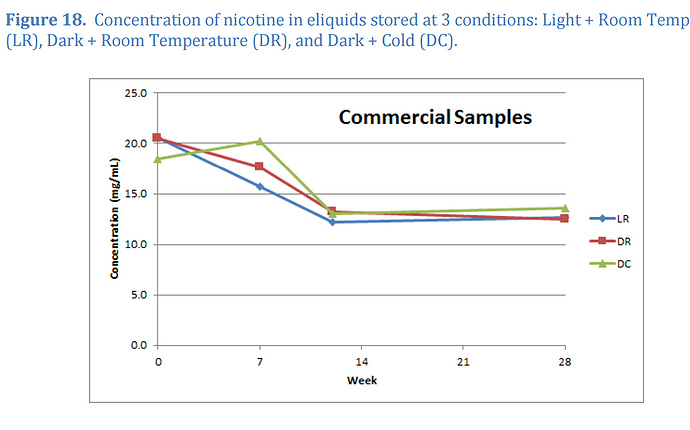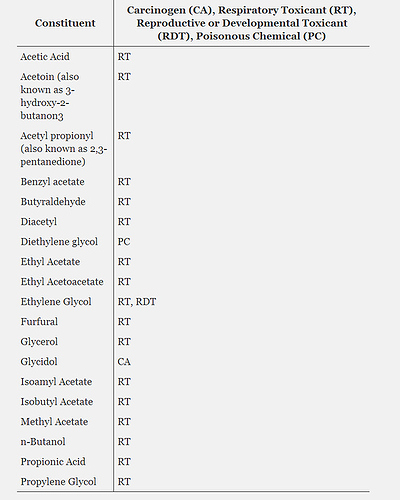NPR did a 10-15 second headline today that actually had the right story. No vape scare mongering, all about elicit non-regulated THC type products, sorry that was an awful paraphrase! But, the truth is circulating!
Nice pun ! Yes, it sounds like quite a “den of inequities” when the public juice seems to lack cognitive clarity differentiating between “saints”/“sinners” seems at best quite missable in solutions for ritualized oxen-goring
Just saying the mainstream is starting to get the story straight. It was only a matter of time.
I am certainly with you in spirit (of informed liberty and personal choices for adults regarding their own bodies and minds) - but the quite intentional opportunistic fallacious association (of Nicotine delivery systems with THC delivery systems) going on only represents a rhetorical “gateway opening” for spooking the public as to the possibilities of far more demonized, and for many disturbing, controlled-substances:
One perhaps technically interesting “spin-off” from the above quoted and linked 2018 US DOJ report is this:
… which (if validly determined) appears to show minimal Nicotine concentration differences in their tested e-juice samples at ~11-28 weeks - between kept: Dark and Cold (DC); Dark and Room Temperature (DR); Light and Room Temperature (LR). It all comes down to whether folks believe a so-called “DOJ deep state”
(IMO, more like a “shallow state” composed of ham-fisted and arrogant bureaucratic “agencies of fear”
 ).
).
I’m not so sure about that ^^^^, which makes the fact that the real FACTS are coming to light, even that more unexpected, and valuable, IMO. I was convinced the “media” was just going to use it to continue the ROLLING over of the vaping / DIY juice industry.
If we can shed some light on that, it might just help.
I feel in the end, big P will be handed the nic, closed systems will be the in thing, and equipment like we have now… will be shunned… I hope all the big (abc) people will be happy rich and live long… mighty pr1cks… yeah I went there… it’s pissing me off too.
Information released about patients in Illinois and Wisconsin (implying a somewhat more mixed picture):
.
Dr Michael Siegel (the impressively outspoken white-coat also quoted above in previous posts on thread):
On a lighter note, yet another tragic manifestation of the “deadly wages of sin” caused by vaping Nicotine:
Source: https://cdn.britannica.com/58/139458-050-D6244464/Dante-Virgil-demons-illustration-Hell-Gustave-Dore-1861.jpg

News I was reading was that the lungs were found with a some kind of oil build-up in their lungs.
Always thought that bio-diesel showed promise. Those particular reports seem to boil down predominantly to known symptoms resulting from the inhalation of Mineral Oil fumes (not the alcohols PG, VG). Interestingly, Palm Oil (cheap source for Glycerin) is “relatively rich” in Tocopherols (that is, Vitamin E molecules), which decompose when heated. If Acetic Acid was possibly added at some point, chemical analysis might indicate the (reported) presence of Vitamin E Acetate (a salt formed with Tocopherols and Acetic Acid). Just sayin’.
Oh well, time to move onto some other fashionable scapegoat with which to slander the sin of “vaping”.  Of prime importance will remain the skillful conflation of Nicotine with already demonized “psychotropics”.
Of prime importance will remain the skillful conflation of Nicotine with already demonized “psychotropics”.
Having worked with Acetic Acid for decades, I would have to say only a total idiot would think of putting that in something you’d inhale. But I guess that’s the point.
I guess that I might have been wise to hold back the Vinegar from my “Free Range Non-GMO Corned Beef Shanks” sauce. Just wanted to “marinate the meat” (so to speak). Much better bovine “bouquet” that way.
.
The Acetate salt appears to be a fairly common formulation of (the various) Vitamin E molecules (up front).
Acetic Acid is item number one on this list of “can be used” acids for Nicotine Salt formulations. Who knew ?
I guess that would be the difference between a process and an additive. That stuff will literally make your sinus’ bleed.
I can dig it. Similarly, Hydrochloric Acid, Sulphuric Acid, Citric Acid (and other common ones widely used in medicinal salt formulations) are not desirable to play with (in any appreciable quantities, whether complexed as a salt in solution, or not) where it comes to one’s internal mucus-membranes - which can be quite finicky.
The FDA places Acetic Acid on their recent proposed list of Respiratory Toxicants (RT) appearing below:
Source: Drums of War in the Ongoing FDA Flavorings Inquisition?
Right on cue, the administration is rolling out it’s most erudite intellectual heavyweights on scientific matters:
It will likely be hard to argue with the gravity of such highly influential thinkers of our time in the White House.
Just damn sad… is all… really sad 
It is as much intended as humor as anything - but the reader must click on the link above for the punch line.
This “breaking news” article puts new a twist on and gives a new meaning to the saying “Katy, bar the door!”:
“Vaping fears prompt Alabama high school to remove bathroom stall doors”
You gotta love corrupt organizations like CDC and WHO that knowingly want to spread misinformation about vaping


